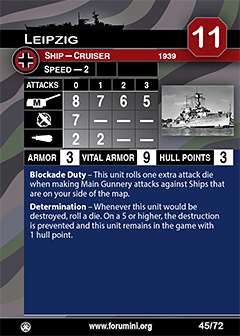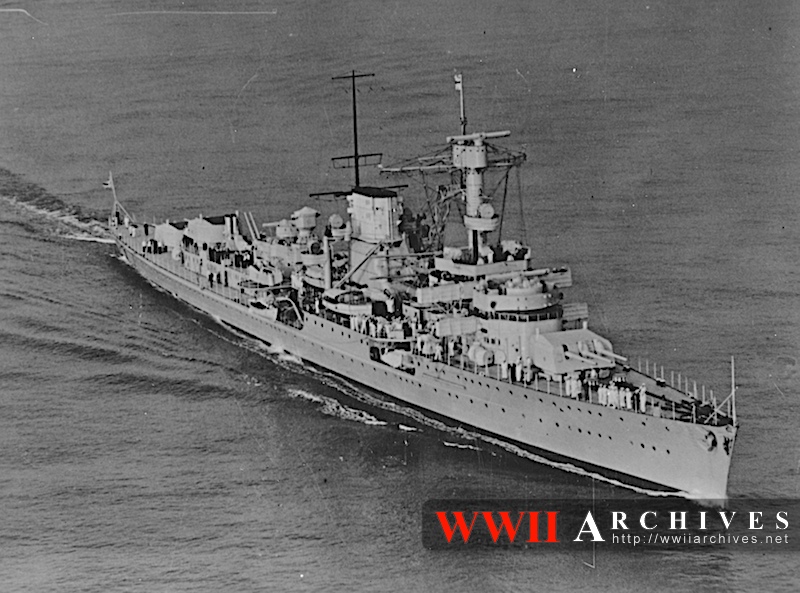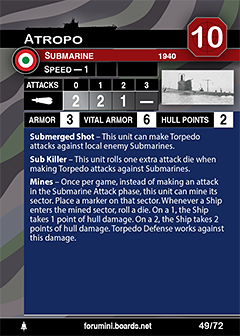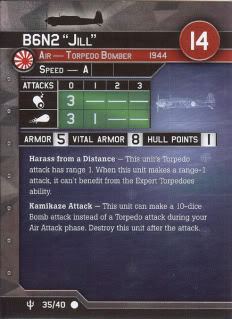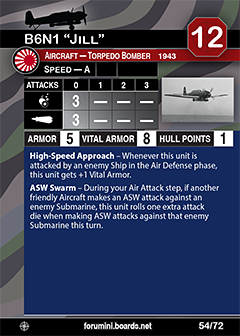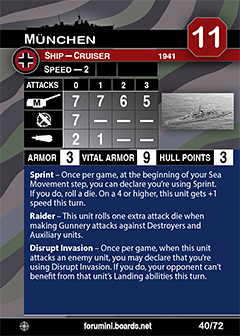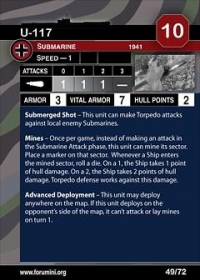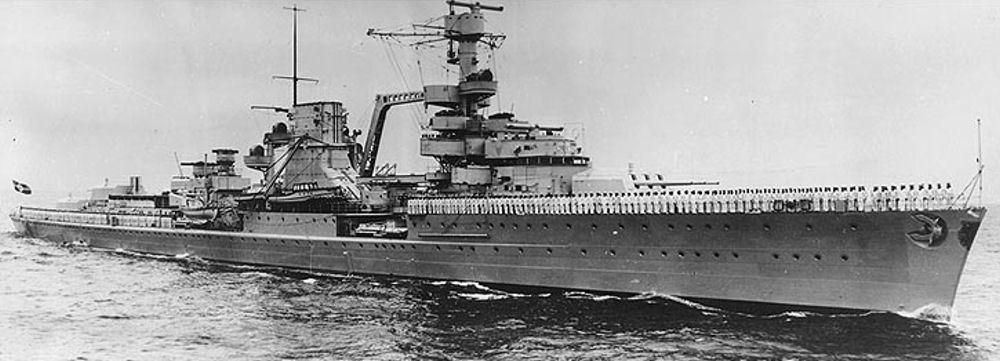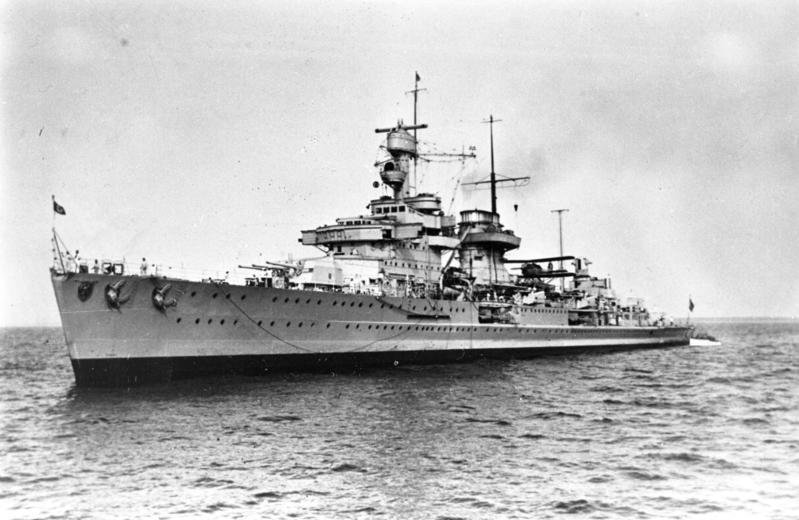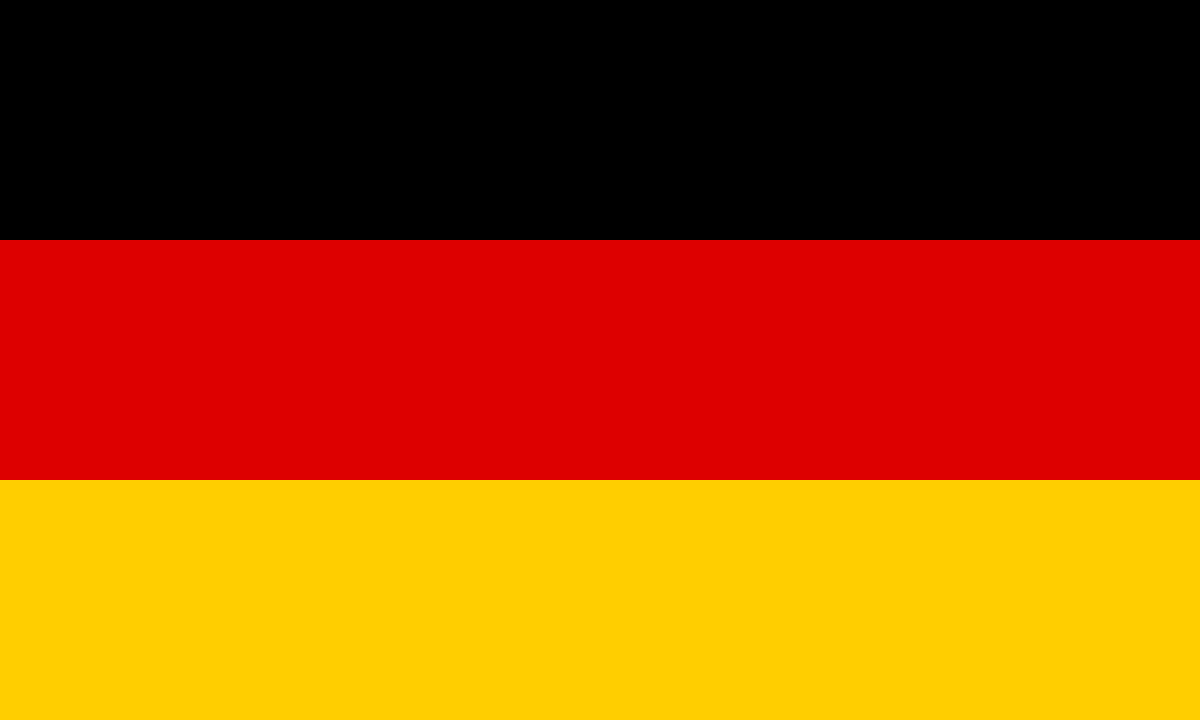Leipzig
| General Type | Ship |
| Unit Type | Cruiser |
| Cost | 10 |
| Set | All Hands On Deck |
| Manufacturer | Forumini |
| Available | 1939 |
| Set ID | 45 |
| Game Class Limits | Leipzig |
| Country | Germany (Details) |
| Prototype | Leipzig (Details) |
| Class | Leipzig (Details) |
| Armor | 3 |
| Vital | 9 |
| Hull Points | 3 |
| Speed | 2 |
| Primary | 8/7/6/5 |
| Torpedoes | 2/2/0/0 |
| AA | 7/0/-/- |
| Special Ability | Blockade Duty |
| Special Ability | Determination |
| Game Rarity | X |
Click to see the details
market
Prototype:
Leipzig was the lead ship of her class of light cruisers built by the German navy. She had one sister ship, Nürnberg. Leipzig was laid down in April 1928, was launched in October 1929, and was commissioned into the Reichsmarine in October 1931. Armed with a main battery of nine 15 cm (5.9 in) guns in three triple turrets, Leipzig had a top speed of 32 knots (59 km/h; 37 mph).
Leipzig participated in non-intervention patrols during the Spanish Civil War. In the first year of World War II, she performed escort duties for warships in the Baltic and North seas. While on one of these operations in December 1939, the ship was torpedoed by a British submarine and badly damaged. Repairs were completed by late 1940, when she returned to service as a training ship. She provided gunfire support to the advancing Wehrmacht troops as they invaded the Soviet Union in 1941.
In October 1944, Leipzig collided with the heavy cruiser Prinz Eugen; the damage was so severe that the navy decided complete repairs were unfeasible. The ship was patched up to keep her afloat, and she helped to defend Gotenhafen from the advancing Red Army in March 1945. She then carried a group of fleeing German civilians, reaching Denmark by late April. After the end of the war, Leipzig was used as a barracks ship for minesweeping forces and was scuttled in July 1946.
Leipzig participated in non-intervention patrols during the Spanish Civil War. In the first year of World War II, she performed escort duties for warships in the Baltic and North seas. While on one of these operations in December 1939, the ship was torpedoed by a British submarine and badly damaged. Repairs were completed by late 1940, when she returned to service as a training ship. She provided gunfire support to the advancing Wehrmacht troops as they invaded the Soviet Union in 1941.
In October 1944, Leipzig collided with the heavy cruiser Prinz Eugen; the damage was so severe that the navy decided complete repairs were unfeasible. The ship was patched up to keep her afloat, and she helped to defend Gotenhafen from the advancing Red Army in March 1945. She then carried a group of fleeing German civilians, reaching Denmark by late April. After the end of the war, Leipzig was used as a barracks ship for minesweeping forces and was scuttled in July 1946.
Class History:
The Leipzig class was a class of two light cruisers of the German Reichsmarine and later Kriegsmarine; the class comprised Leipzig, the lead ship, and Nürnberg, which was built to a slightly modified design. The ships were improvements over the preceding Königsberg-class cruisers, being slightly larger, with a more efficient arrangement of the main battery and improved armor protection. Leipzig was built between 1928 and 1931, and Nürnberg followed between 1934 and 1935.
Both ships participated in the non-intervention patrols during the Spanish Civil War in 1936 and 1937. After the outbreak of World War II, they were used in a variety of roles, including as minelayers and escort vessels. On 13 December 1939, both ships were torpedoed by the British submarine HMS Salmon. They were thereafter used in secondary roles, primarily as training ships, for most of the rest of the war. Leipzig provided some gunfire support to German Army troops fighting on the Eastern Front.
Both ships survived the war, though Leipzig was in very poor condition following an accidental collision with the heavy cruiser Prinz Eugen late in the war. Leipzig was therefore used as a barracks ship before being scuttled in 1946. Nürnberg, however, emerged from the war largely unscathed, and as a result, was seized by the Soviet Navy as war reparations, and commissioned into the Soviet fleet as Admiral Makarov; she continued in Soviet service until the late 1950s, and was broken up for scrap by 1960.
Both ships participated in the non-intervention patrols during the Spanish Civil War in 1936 and 1937. After the outbreak of World War II, they were used in a variety of roles, including as minelayers and escort vessels. On 13 December 1939, both ships were torpedoed by the British submarine HMS Salmon. They were thereafter used in secondary roles, primarily as training ships, for most of the rest of the war. Leipzig provided some gunfire support to German Army troops fighting on the Eastern Front.
Both ships survived the war, though Leipzig was in very poor condition following an accidental collision with the heavy cruiser Prinz Eugen late in the war. Leipzig was therefore used as a barracks ship before being scuttled in 1946. Nürnberg, however, emerged from the war largely unscathed, and as a result, was seized by the Soviet Navy as war reparations, and commissioned into the Soviet fleet as Admiral Makarov; she continued in Soviet service until the late 1950s, and was broken up for scrap by 1960.
Country:
Germany is a Western European country with a landscape of forests, rivers, mountain ranges and North Sea beaches. It has over 2 millennia of history. Berlin, its capital, is home to art and nightlife scenes, the Brandenburg Gate and many sites relating to WWII. Munich is known for its Oktoberfest and beer halls, including the 16th-century Hofbräuhaus. Frankfurt, with its skyscrapers, houses the European Central Bank.
Item created by: gdm
on 2015-08-10 17:00:46
Last edited by: gdm on 2019-08-13 22:15:14
If you see errors or missing data in this entry, please feel free to log in and edit it. Anyone with a Gmail account can log in instantly.
Last edited by: gdm on 2019-08-13 22:15:14
If you see errors or missing data in this entry, please feel free to log in and edit it. Anyone with a Gmail account can log in instantly.


